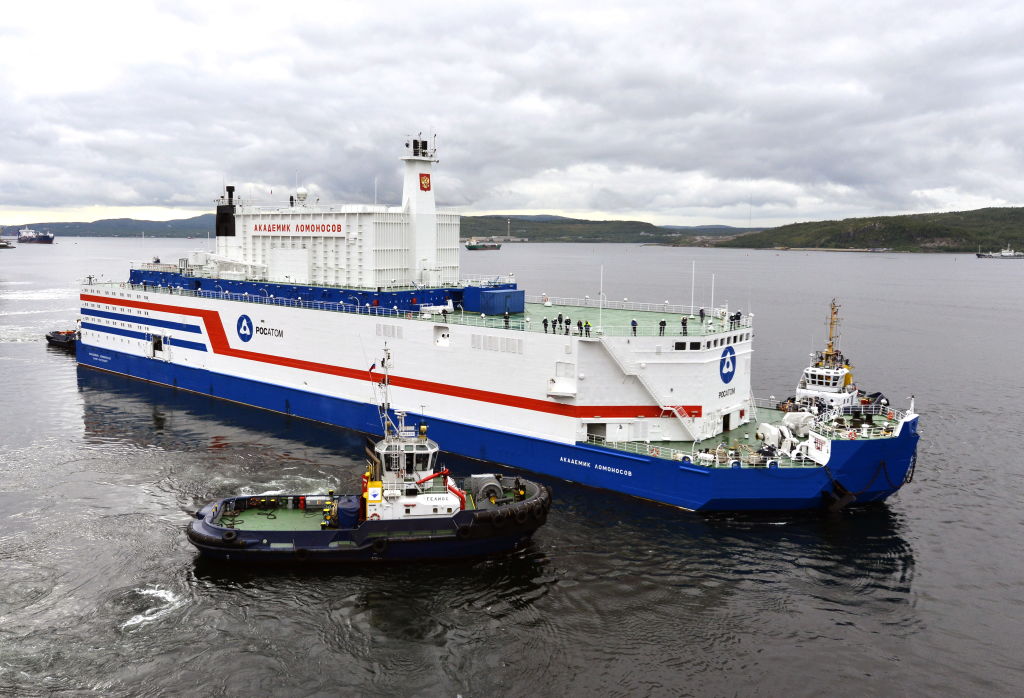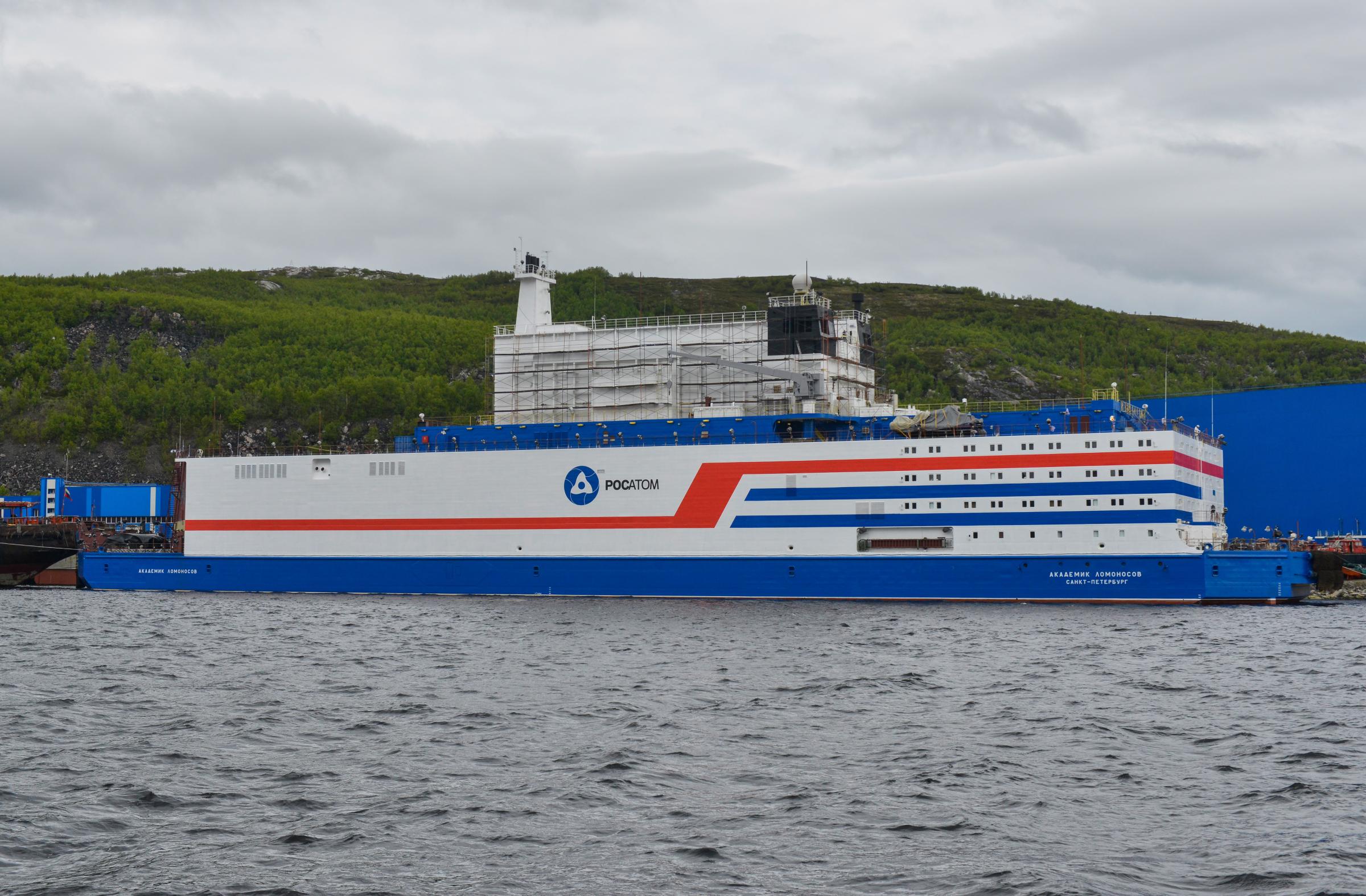
On Friday, an unusual kind of vessel set sail from the Arctic city of Murmansk, Russia, for a destination in the country’s far east––a floating nuclear power plant equipped with two reactors.
The vessel, dubbed the Akademik Lomonosov, is set to travel about 2,900 miles to the Arctic port town of Pevek, which has a population of about 4,000 people, where it will be loaded with nuclear fuel and put in place to provide power to the region, according to Russia’s state nuclear corporation, ROSATOM.
Russia’s far east may just be the beginning. ROSATOM has said that it’s in talks with potential customers for the floating power unit, and sees “significant market potential” in Southeast Asia, Latin America and Africa. The vessel’s reactors can generate 70 megawatts of electric power and 50 gigacalories an hour of heat energy, according to ROSATOM––enough to support a city of up to 100,00 people.
Why are people worried about the floating nuclear power plant?

However, the vessel has sparked concerns about safety as a result of Russia’s tarnished nuclear record. Just this summer, there were two deadly accidents involving Russian nuclear power. On July 1, 14 sailors were killed in a fire on the secretive Losharik nuclear submarine; then on Aug. 8, five scientists were killed when a missile test on Russia’s White Sea failed.
The Kursk nuclear submarine sank on the Barents Sea on Aug. 12, 2000, killing 118 people on board, and scientists have recent found that an nuclear sub that sank in the Barents Sea, the Komsomolets––which was lost in 1989––is emitting high levels of radiation.
Then there’s Chernobyl, the 1986 nuclear power station meltdown in the former Soviet Union that is perhaps the biggest and most famous civil nuclear disaster in history. It exposed potentially hundreds of thousands of people to radiation.
A high-profile HBO series, Chernobyl, has renewed attention on the devastating consequences of a nuclear accident––and the potential of political machinations that can get in the way of public safety.
Environmental activist group Greenpeace has publicly raised concerns about the Russian nuclear power vessel. In an April blog post titled, “The next Chernobyl may happen in the Arctic,” Konstantin Fomin of Greenpeace called for the program to be brought to a halt.
“This is an example of how new technologies are put into use without reflection on their safety,” Fomin wrote, adding, “Greenpeace demands the abandonment of expensive and dangerous atomic energy.”
ROSATOM insists that the vessel is designed to be safe, and will not harm the environment, writing in a statement that the vessel “is designed with a great margin of safety that exceeds all possible threats and makes nuclear reactors invincible for tsunamis and other natural disasters.”
News in Russia has mainly emphasized that that the technology is new and innovative, and that it could help to provide power to remote parts of the country.
“This is an absolute breakthrough in small nuclear power,” said Pavel Ipatov, the director of special projects for a section of ROSATOM’s nuclear power subsidiary, according to Russian news service Vesti.ru. “Russia is the first country which has gotten this technology. It has very good prospects.”
Is it actually safe?
In fact, putting nuclear reactors on ships is not new. Nuclear reactors have been placed on ships, including to provide propulsion, for more than 50 years. A World War II-era cargo ship, the SS Charles H. Cugle, was converted into a nuclear power plant in the 1960s. It was used to provide the U.S. Army with power. The vessel was stationed at the Panama Canal Zone from 1968 to 1976, according to the U.S. Army Corps of Engineers.
Robert Bean, an associate professor of nuclear engineering at Purdue University, tells TIME that there is a different set of concerns for nuclear reactors at sea than for reactors on land. Reactors at sea must be protected from storms, and have differing security concerns because they can be approached by other ships.
However, says Bean, the Russians are employing a type of reactor that has been used for a long time on its ice-breaking ships––the KLT-40S––and will be similar to the design of reactors the Russians use in submarines. Bean says that the design is very similar other reactors used around the world.
“I don’t see any reason why it’s less safe,” said Bean. “At first look you go, whoa, it’s different. And that’s my point––it’s different, but I don’t think that means it’s less safe.”
“It’s always possible that such a thing could happen. However, every reactor is designed to try to prevent that, the procedures are all designed to try to prevent that and when it does happen––for example Fukishima––the very first thing once it was dealt with, every other reactor in the world looked a their design and said, what could we change, how would we make sure this never happens to us?”
Steven Biegalski, the Chair of Nuclear and Radiological Engineering and Medical Physics Program at Georgia Institute of Technology, tells TIME that whether a nuclear reactor is kept on a boat or on land, the priority is the same––making sure that that the core is kept cool if it’s shut down.
“The nice thing is that if you submerge the whole reactor system, including the reactor vessel, under water, it’s going to get as much cooling as you can possibly want,” Biegalski says. “If you put the reactor core in an Arctic Ocean off the coast of Russia, would probably provide enough of a cooling sink that you don’t have to worry about the reactor concerns.”
What is the biggest concern?
However, Biegalski tells TIME that if there’s a reason to be concerned about the reactor, it’s because Russia hasn’t been open about its nuclear program and past accidents.
“It’s not a new concept, it’s something that has been done in the past, and if done correctly can be done very safely and without concerns,” Biegalski says. “I will say that I am concerned currently about Russia’s transparency.”
While he emphasizes that the design of the reactor is very different than the Chernobyl reactor, he’s concerned that Russia didn’t learn a big lesson after the 1986 disaster––that failing to notify the international community quickly was “irresponsible.”
“It may not have allowed local governments and local organizations to respond properly. It also means you may not get the help that you could get in a timely manner, because there may be people standing by to help that might not be there if you don’t ask them to be,” Biegalski says.
He notes that the slow release of information after the most recent nuclear accident may be a warning sign.
Correction, Aug. 24
The original version of this story misstated Robert Bean’s title. He is an assistant professor, not an associate professor.
More Must-Reads from TIME
- Cybersecurity Experts Are Sounding the Alarm on DOGE
- Meet the 2025 Women of the Year
- The Harsh Truth About Disability Inclusion
- Why Do More Young Adults Have Cancer?
- Colman Domingo Leads With Radical Love
- How to Get Better at Doing Things Alone
- Michelle Zauner Stares Down the Darkness
Contact us at letters@time.com